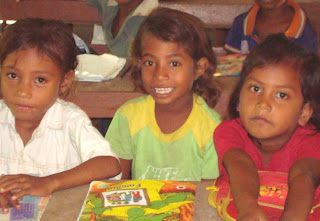Sunday, January 27, 2008
'Avo Helen' . . .
It’s hard to believe that a week has passed since my friend/host Megan met me at Dili airport. As we drove to her house we went past an IDP (Internally Displaced Persons) camp, home for about 5,000 thousand people, since the 2006 crisis. It is quite bizarre to witness these conditions when Australia seems like just a stone’s throw away (an hour and a half flight from Darwin).


Megan’s house is lovely and right on the beach north of Dili in a village called Tasi Tolu (means three bodies of water). I arrived with the “Weekend Australian”, (according to Megan, a required gift from anyone arriving from Oz!) As her expat friends arrived throughout the AM for a Sunday visit they immediately exclaimed upon sighting the paper and put their noses into it.
Megan, an epidemiologist working with WHO, has been so helpful and supportive of my quest to get more public health hands on experience and has arranged a couple of work experiences. The first of which was joining the team from AAI (Australia Aid International) to head to the island of Atauro, about 25 km offshore from Dili.
Headed by health coordinator Penny, who is an Australian nurse, there were a total of 7 of us on the team, 4 of whom are Timorese. It was a fabulous experience seeing how the system worked, running local clinics and doing health promotion out on the 140 sq. km. island of Atauro where about 9,600 people reside. By the end of the week we had seen about 230 people in 4 clinics and done health promotion in a primary school of 250. I was able to do some basic assessments and also help organize and dispense the medicines. Two of the clinics were accessed by a small outrigger boat. Pretty amazing to set off from the glorious beach/base camp across the CLEAR turquoise ocean, with the green rugged mountains as a spectacular back drop!





The locals were very friendly and grateful for the help. Malnutrition and parasites are ubiquitous, especially in the children….lots of upper respiratory infections too. The life expectancy is alarmingly low in East Timor…mid-50’s. I was introduced as “Avo Helen”… Grandmother Helen! Tetum and Portuguese, are the lingua francas of East Timor. I am doing my best with language acquisition. No verbs are conjugated in Tetum and the vocabulary is limited, so there’s actually hope for me yet! For example “moras” means illness, disease and pain. “Bibi maten” means seizure, but translates literally as dead goat!



Tomorrow I head into the mountains, some 70 km to the southwest of Dill, to the village of Emera, then plan to return to the island of Atauro the week after next. It will be good to maintain the continuity of care out there.
Heading off for Dili explorations with Megan now….
Just before departing for the mountains Helen sent this 'P.S.' of random observations for the blog.
- Dili has several km. of sea frontage without any high rises. . Still too much instability, with very basic infrastructure, rehab and development. The crescent shaped beach front is book-ended at the eastern end with a large Christ statue on a bluff overlooking the sea. If it ever got cleaned up, this could turn into a Key West or Gold Coast/Miami Beach type of place, but don't hold your breath. Still so much infrastructure repair and rehab/development of basic services to be done.
- This is the city of white Land Cruisers and utes...many, many UN and many for NGOs. Other vehicles are taxis and some buses crammed to the hilt with passengers. Lots of motorbikes too. Helmets not exactly standard, many just glorified ice cream containers.
- Roads are in terrible shape...street lights are random with poor placement...way off to the side.
- Little mobile stall fronts are ubiquitous, selling a large spectrum of goods: trinkets, phone cards, plastic liter water bottles filled with petrol or fruit.
- Pigs and piglets wandering on the roads snorffeling through rubbish heaps. LOTS of PLASTIC RUBBISH...
- Most expats smoking many cigarettes, with their cell phones close at hand. They all do text messaging a mile a minute.
- Though it appears very relaxed, there is definitely a large military presence here.
- We went out for lunch in a lovely open air restaurant overlooking the water...fancy for Timor. Lunch for two with two large fresh OJs was $22USD. (USD is the currency here.)
- Recognised the Australian ambassador and his wife at the next table from the Australia Day celebrations on Saturday...they both wear Birkenstocks!
- Saw Kristy Gusmao at the beach yesterday...she was the first, first lady of East Timor. This is a small town!
- No industry here, but there's a bit of smog over the town visible from offshore as a result of fires burning from the IDP camps and other places too.
- The American Embassy is like a fortress, with the largest compound. The Chinese Embassy is under construction and looks like it will huge. Could they be at all interested in the offshore oil too?
 OUTSIDE DILI HOSPITAL................INSIDE DILI HOSPITAL
OUTSIDE DILI HOSPITAL................INSIDE DILI HOSPITAL





